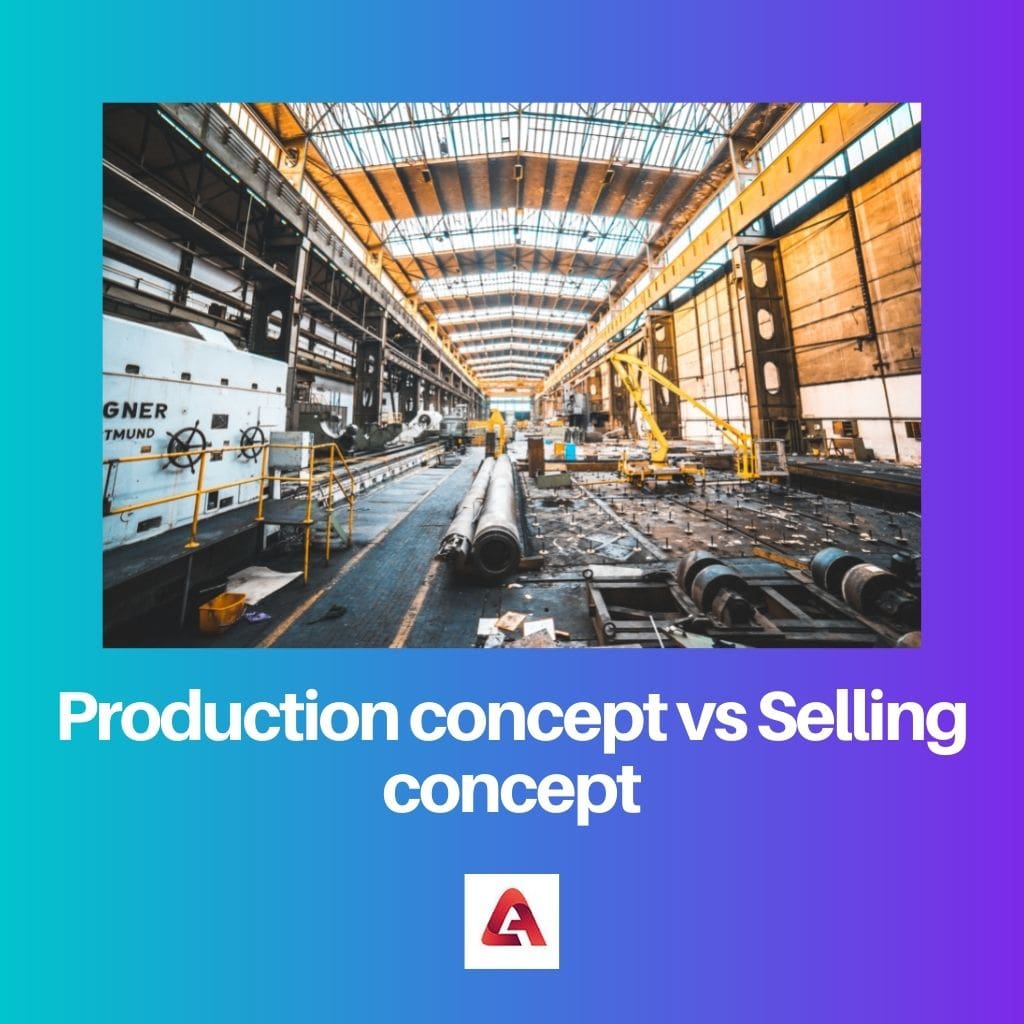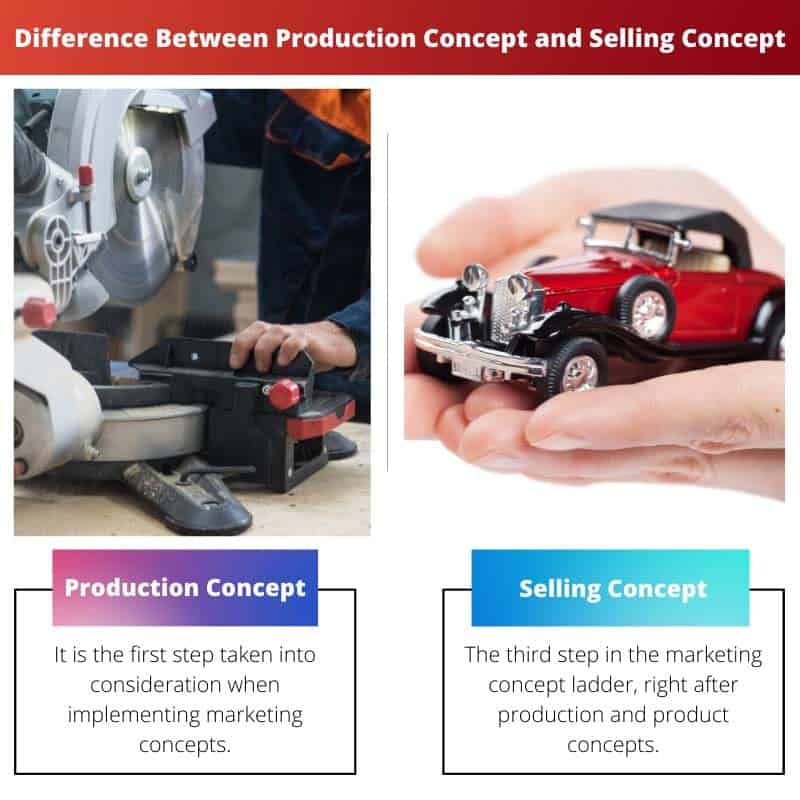Production Concept emphasizes maximizing efficiency and minimizing costs by focusing on mass production. In contrast, Selling Concept centers around aggressive sales and promotional efforts to convince customers to buy existing products, often neglecting their actual needs and preferences.
Key Takeaways
- Focus: The production concept emphasizes efficiency and economies of scale, while the selling concept prioritizes advertising and sales promotion.
- Customer needs: The production concept assumes customers prefer widely available and affordable products, whereas the selling concept assumes customers must be persuaded to buy products.
- Market conditions: The production concept works best in supply-driven markets, while the selling concept suits demand-driven markets.
Production Concept vs Selling Concept
The difference between the production concept and selling concept is that the former deals with ensuring the quality and standards of the product are above par, while the latter deals with finding ways to promote the products in the best possible way.

The production concept is one of the oldest marketing concepts and deals with the product component of the business, particularly product quality (efficiency and costs).
The selling concept deals with persuading a customer to buy the company’s product with the help of promotions and various selling tactics.
Comparison Table
| Feature | Production Concept | Selling Concept |
|---|---|---|
| Focus | Efficient production and low costs | Selling existing products and persuading customers to buy |
| Starting Point | Factory and production capabilities | Target market and customer needs |
| Key Activity | Streamlining production processes and achieving economies of scale | Aggressive promotion and sales techniques |
| Customer View | Customers will buy readily available and affordable products | Customers need convincing and persuasion |
| Product Development | Focuses on existing products and minor improvements | May neglect product development or prioritize features that are easy to produce |
| Marketing | Limited role, focus on promoting existing products | Extensive use of advertising, sales promotions, and personal selling |
| Business Planning | Short-term, focused on meeting production targets and sales quotas | Long-term, considers market trends and customer needs |
| Success | Measured by volume of production and sales | Measured by customer satisfaction and long-term profitability |
| Examples | Basic commodities (e.g., nails, screws) | Vacuum cleaners with aggressive door-to-door sales tactics |
What is Production Concept?
The production concept is a marketing philosophy that revolves around the idea that consumers prefer products that are widely available and affordable. This concept focuses on maximizing production efficiency and reducing costs to make products accessible to a larger audience.
Key Characteristics
1. Efficiency in Production
The primary emphasis of the production concept is on optimizing the production process. Companies strive to achieve economies of scale by producing large quantities of goods, which helps in reducing the per-unit production cost.
2. Mass Production
Mass production is a core element of the production concept. It involves the large-scale manufacturing of standardized products, enabling companies to meet the demands of a broad market. This approach often involves assembly line processes to enhance efficiency.
3. Cost Minimization
To make products affordable for a wide range of consumers, cost minimization is crucial. Companies employing the production concept focus on streamlining operations, negotiating favorable deals with suppliers, and using cost-effective materials.
4. Limited Product Variations
The product offerings under the production concept are often limited in terms of variations and customization. Standardization is key to achieving economies of scale and cost savings.
Advantages
1. Economies of Scale
One of the primary advantages of the production concept is the ability to benefit from economies of scale. Producing in large volumes helps spread fixed costs over more units, leading to lower production costs per unit.
2. Cost Efficiency
By focusing on efficient production processes and cost minimization, companies can offer products at lower prices, making them more attractive to a broader consumer base.
3. Quick Availability
Mass production enables quick and continuous availability of products in the market. This immediacy can be advantageous in meeting high consumer demand.
Criticisms
1. Lack of Customer Focus
The production concept often neglects customer preferences and needs. Companies may prioritize efficiency and cost-cutting over understanding and satisfying customer desires.
2. Risk of Obsolescence
In markets where consumer preferences change rapidly, a focus solely on mass production may lead to the creation of outdated products, increasing the risk of obsolescence.
3. Environmental Concerns
The emphasis on mass production and cost reduction can contribute to environmental issues, such as excessive resource consumption and waste generation.
Examples
A classic example of a company following the production concept is Henry Ford’s approach to manufacturing the Model T Ford. The standardized assembly line processes and mass production techniques made the car affordable for a broader segment of the population.

What is Selling Concept?
The selling concept is a marketing philosophy that revolves around the idea that consumers are unlikely to buy enough of a product or service unless it is actively promoted through sales efforts. This approach assumes that consumers may not be sufficiently motivated to seek out and purchase a product on their own, and thus, businesses must employ aggressive selling and promotional strategies to stimulate demand.
Historical Background
The selling concept gained prominence in the mid-20th century, especially during a time when production capacities increased, leading to more emphasis on pushing products into the market rather than relying solely on consumer demand.
Core Characteristics
Product Focus
One key aspect of the selling concept is its emphasis on the product. Companies adopting this philosophy tend to prioritize the features and qualities of their products, believing that a strong sales effort can convince customers to buy.
Aggressive Promotion
The selling concept relies heavily on aggressive promotional activities. This includes advertising, personal selling, and other promotional techniques to create awareness and persuade potential customers to make a purchase.
Short-Term Orientation
This concept often has a short-term orientation, focusing on immediate sales rather than building long-term relationships with customers. The primary goal is to move existing inventory and generate revenue quickly.
Applicability
High-Involvement Products
The selling concept is often more applicable to high-involvement products or those that require significant customer consideration. In such cases, personal selling and persuasive techniques become crucial to influencing consumer decisions.
Unsought Goods
Products that fall under the category of unsought goods, such as life insurance or funeral services, can benefit from the selling concept. These are products that consumers may not actively seek but could be persuaded to purchase with effective selling strategies.
Criticisms
Customer-Centric Concerns
Critics argue that the selling concept can be detrimental to customer-centric business models. Focusing solely on sales efforts may lead to neglecting customer needs and preferences, potentially damaging long-term relationships.
Limited Market Understanding
Relying heavily on selling efforts may hinder a company’s ability to truly understand the market. Without a solid understanding of customer needs and market trends, businesses may struggle to adapt and innovate.

Main Differences Between Production Concept and Selling Concept
Production Concept:
- Focus on Efficiency: Emphasizes efficient production processes and cost reduction.
- Supply-Driven: Assumes that consumers will favor products that are widely available and affordable.
- Quality and Quantity: Prioritizes high production volumes and maintaining product quality.
- Inward-Focused: Company-centric approach, with a primary focus on manufacturing and distribution.
Selling Concept:
- Aggressive Promotion: Highlights the need for extensive promotional activities to sell products.
- Customer Acquisition: Emphasizes selling what the company produces rather than understanding customer needs.
- Short-Term Focus: Often concentrates on achieving sales targets in the short term.
- Challenges in Saturated Markets: Suited for situations where products are in abundance, and competition is high.

- https://www.sciencedirect.com/science/article/pii/0019850173900254
- https://journals.sagepub.com/doi/abs/10.1177/002224298605000207

The production concept prioritizes product quality, but the selling concept seems to prioritize persuading customers, even if the product quality is not up to par.
This is true. Many companies focus more on aggressive sales tactics rather than improving the quality of their products.
It’s like companies are willing to compromise product quality just to make sales. It’s a concerning trend in the market.
The production concept seems very traditional compared to the modern selling concept. It’s interesting to know how marketing strategies have evolved over time.
I agree, Millie07. It’s fascinating to see how the concepts have changed to adapt to customer needs and market conditions.
The production concept seems outdated in today’s consumer-driven markets. Companies are more focused on selling and advertising their products.
The steps involved in the production and selling concepts are quite detailed and interesting to understand. It’s crucial for businesses to choose the right approach based on market conditions.
The production concept’s emphasis on product quality and efficiency is commendable. It’s an essential aspect for consumer satisfaction.
Great insights into the production and selling concepts. The article provides a valuable understanding of how businesses approach marketing strategies.
The article provides a thorough comparison through the in-depth components and purpose of both concepts. It’s informative and well-structured.
The article provides a clear and comprehensive comparison between the production and selling concepts. It really helps in understanding the different approaches of the two concepts in marketing.
The selling concept seems more aggressive and focused on pushing products to customers rather than genuinely meeting customer needs.
The differences in the production and selling concepts are well-explained. It’s intriguing to see the shift from manufacturing-focused approaches to aggressive sales tactics.